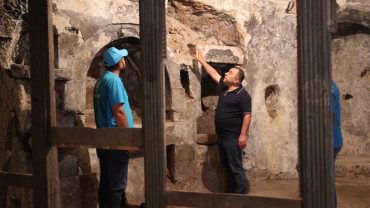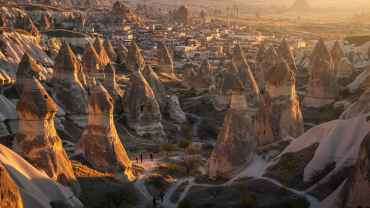Introduction to Hattuşa
Nestled in the heart of central Turkey, the ancient city of Hattuşa is one of Anatolia’s most captivating archaeological sites. Once the thriving capital of the powerful Hittite Empire, Hattuşa is a place where myth meets history, and every stone whispers tales of a bygone era. Its significance, beauty, and preservation have earned it a coveted spot on the UNESCO World Heritage list, yet it remains one of Turkey’s lesser-known historical treasures.
Historical Overview of Hattuşa
Hattuşa was the epicenter of the Hittite civilization, which flourished between 1600 BCE and 1200 BCE. Located near the modern village of Boğazkale, it served as the political and religious heart of the Hittites. The city was meticulously planned and fortified, reflecting its importance and the sophistication of its builders. Hittite kings ruled vast territories from this city, and their influence stretched across much of Anatolia and into northern Syria.
The Discovery and Excavation
Although known to locals for centuries, the significance of the ruins wasn’t fully realized until the early 20th century. German archaeologist Hugo Winckler initiated excavations in 1906, uncovering royal archives filled with cuneiform tablets. These discoveries were pivotal in understanding Hittite history and establishing Hattuşa’s identity. Excavations continue to this day, revealing more about the city’s complex past.
Architecture and Urban Planning
Hattuşa’s cityscape is a marvel of ancient engineering. Built on a rocky terrain, the city was divided into upper and lower sections, surrounded by massive stone walls and gates. The use of local limestone and advanced building techniques speaks volumes about Hittite craftsmanship. Streets, temples, royal residences, and administrative buildings were strategically placed, showcasing a deep understanding of urban design.
The Great Temple and Religious Significance
At the heart of Hattuşa lies the Great Temple, dedicated to the Storm God and the Sun Goddess, the principal deities of the Hittite pantheon. This temple was not just a place of worship but also a hub of administrative activity. Artifacts suggest that religious ceremonies here were elaborate, involving music, dance, and offerings—highlighting the Hittites’ deep spiritual beliefs.
City Gates and Fortifications
Hattuşa is renowned for its monumental city gates. Among the most famous are the Lion Gate, adorned with imposing lion statues; the King’s Gate, decorated with warrior reliefs; and Yerkapı, a massive stone rampart with an underground tunnel. These gates were not only defensive structures but also powerful symbols of the city’s might and artistry.
Royal Archives and Cuneiform Tablets
One of Hattuşa’s most groundbreaking discoveries was its royal archives. Over 30,000 clay tablets inscribed with cuneiform script have been unearthed, documenting everything from legal codes and treaties to myths and prayers. These texts have been instrumental in reconstructing Hittite history and understanding their governance, diplomacy, and culture.
Daily Life in Hattuşa
Life in Hattuşa was complex and hierarchical. The city housed royalty, priests, soldiers, artisans, and farmers. Markets bustled with activity, and public spaces were used for gatherings and religious festivities. The cuneiform tablets also provide glimpses into family life, dietary habits, and economic transactions, painting a vivid picture of daily life in this ancient metropolis.
The Fall of the Hittite Empire
The decline of Hattuşa, and the Hittite Empire as a whole, occurred around 1200 BCE—a time often referred to as the Late Bronze Age Collapse. This period saw the sudden and widespread downfall of several powerful civilizations in the eastern Mediterranean and Near East. The reasons for the Hittite collapse remain debated among historians, with theories ranging from internal strife and famine to invasions by the mysterious Sea Peoples. As the capital, Hattuşa was eventually abandoned, its once-grand halls falling into silence and disrepair.
UNESCO World Heritage Status
Recognizing its historical and cultural significance, UNESCO designated Hattuşa as a World Heritage Site in 1986. The criteria for this designation include the city’s exemplary urban planning, well-preserved architecture, and the treasure trove of textual records. The site stands today as a testament to the ingenuity and resilience of the Hittite civilization, offering invaluable insights into one of the ancient world’s major powers.
Hattuşa Today: A Travel Guide
For modern travelers, Hattuşa offers a rare opportunity to walk in the footsteps of ancient kings. The sprawling site features clearly marked paths, informative signposts, and areas where you can freely explore ruins. Must-see highlights include the city gates, the Great Temple, and the Royal Citadel. Many visitors find the site’s serenity and remoteness a profound contrast to more commercialized tourist attractions, making it ideal for introspective exploration.
Best Time to Visit Hattuşa
The best months to visit Hattuşa are during spring (April to June) and autumn (September to October). During these times, the weather is mild, and the surrounding landscape bursts into vibrant colors. Summers can be hot and dry, while winters often bring snow, which, although picturesque, can limit access to some areas of the site.
Getting to Hattuşa
Hattuşa is located near the modern town of Boğazkale in Çorum Province. It’s accessible by road from major cities like Ankara (approximately 3.5 hours by car) and Cappadocia (around 4 hours). While public transportation is limited, car rental or private tours are popular options. Boğazkale also offers a few lodging and dining choices for those wishing to stay overnight.
Nearby Attractions
The area surrounding Hattuşa holds additional treasures for curious travelers. The rock sanctuary of Yazılıkaya, just a short distance away, features exquisite rock reliefs depicting Hittite gods in procession. The Boğazkale Museum is another must-visit, showcasing artifacts from the Hattuşa excavations. Together, these sites provide a fuller picture of Hittite spiritual and daily life.
Cultural Significance in Modern Turkey
Hattuşa holds a special place in Turkey’s national heritage. It represents a connection to the ancient civilizations that once thrived in Anatolia, predating even the Greeks and Romans. Hittite symbols and motifs are frequently used in Turkish art and culture, and schoolchildren learn about Hattuşa as part of their history curriculum. Its legacy is proudly preserved and promoted by both government and local communities.
Conservation Efforts and Archaeological Research
Maintaining a site as expansive as Hattuşa requires ongoing conservation. Collaborative efforts between Turkish authorities and international archaeologists have led to significant restoration and preservation work. New technologies such as 3D mapping and remote sensing are being used to explore unexcavated areas and monitor site integrity. These efforts ensure that future generations can continue to learn from and be inspired by Hattuşa.
FAQs About Hattuşa
1. Where is Hattuşa located?
Hattuşa is located near Boğazkale in the Çorum Province of central Turkey.
2. Why is Hattuşa significant?
It was the capital of the Hittite Empire and a center for political, religious, and cultural activities during the Late Bronze Age.
3. Can I visit Hattuşa today?
Yes, the site is open to visitors year-round, though spring and fall are the best seasons to explore comfortably.
4. What should I see at Hattuşa?
Highlights include the Lion Gate, Yerkapı, the Great Temple, and the royal archives.
5. How long does it take to explore Hattuşa?
A thorough visit can take 3 to 5 hours, depending on your pace and interest level.
6. Is there an entrance fee for Hattuşa?
Yes, a modest fee is charged. Discounts are available with Turkish museum passes.
Conclusion: Why Hattuşa Should Be on Your Bucket List
Hattuşa is not just a site for history buffs—it’s a portal into the soul of ancient Anatolia. Walking its stony paths, standing before its mighty gates, and pondering the lives once lived there, visitors gain more than knowledge—they gain perspective. For anyone traveling through Turkey, especially those interested in off-the-beaten-path experiences, Hattuşa is a powerful reminder of the civilizations that shaped our world.



Comment (0)